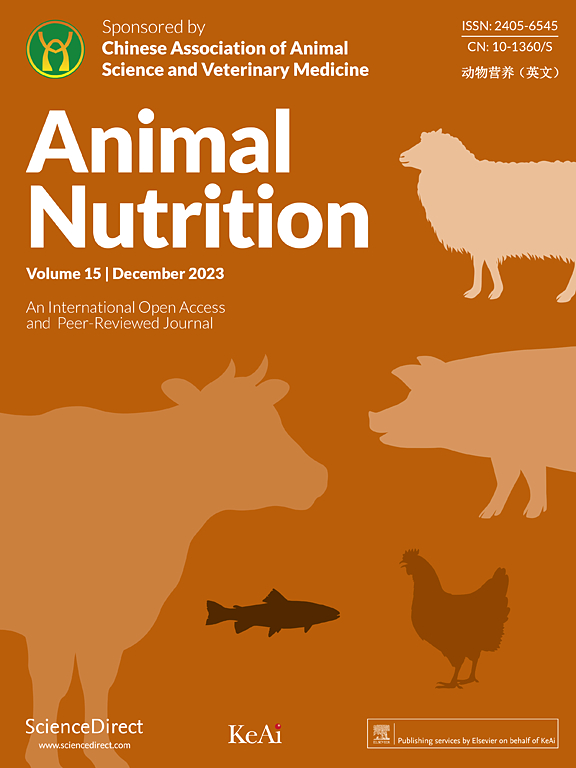Effects of red clover isoflavone on lactation performance, milk quality and nitrogen metabolism in dairy cows
IF 6.1
1区 农林科学
Q1 AGRICULTURE, DAIRY & ANIMAL SCIENCE
引用次数: 0
Abstract
Reducing nitrogen loss and improving nitrogen utilization efficiency in dairy cows can reduce economic costs and mitigate the environmental impact of nitrogen emissions. Red clover isoflavone, a natural compound derived from plant extract, has the advantage of biological safety. This study aimed to investigate the effects of red clover isoflavone on lactation performance and nitrogen metabolism in dairy cows. Sixty-eight Holstein cows (165 ± 21 d in milk, 710 ± 75 kg initial body weight, 2.30 ± 1.21 parities, 33.93 ± 3.81 kg/d milk yield) were chosen in a randomized complete block design. Cows were divided into 5 blocks by milk yield and randomly assigned to 4 treatments (17 cows per treatment). The experimental period lasted 84 d, during which cows were fed a basal diet supplemented with red clover extract (RCE) at 0, 2, 4, or 8 g/kg of total mixed rations (TMR) on a dry matter (DM) basis. These levels corresponded to red clover isoflavones of 0, 0.46 (0.31 g/kg formononetin and 0.15 g/kg biochanin A), 0.93 (0.67 g/kg formononetin and 0.26 g/kg biochanin A), and 1.83 g/kg (1.32 g/kg formononetin and 0.52 g/kg biochanin A), respectively. With increasing supplementation of RCE in TMR, milk yield increased quadratically by 4.65% to 9.64% (红三叶草异黄酮对奶牛泌乳性能、牛奶品质和氮代谢的影响
减少奶牛氮素损失,提高奶牛氮素利用效率,可以降低经济成本,减轻氮素排放对环境的影响。红三叶草异黄酮是一种从植物提取物中提取的天然化合物,具有生物安全性的优点。本试验旨在研究红三叶草异黄酮对奶牛泌乳性能和氮代谢的影响。采用完全随机区组设计,选取泌乳165±21 d、初始体重710±75 kg、胎次2.30±1.21、产奶量33.93±3.81 kg/d的荷斯坦奶牛68头。按产奶量分成5块,随机分为4个处理(每个处理17头)。试验期84 d,分别饲喂在基础饲粮中添加红三叶草提取物(RCE)的试验饲粮,以干物质(DM)为基础,分别添加0、2、4和8 g/kg的总混合日粮(TMR)。红三叶草异黄酮含量分别为0、0.46 (0.31 g/kg芒柄花素和0.15 g/kg生物茶素A)、0.93 (0.67 g/kg芒柄花素和0.26 g/kg生物茶素A)和1.83 g/kg (1.32 g/kg芒柄花素和0.52 g/kg生物茶素A)。随着RCE在TMR饲粮中添加量的增加,产奶量二次提高4.65% ~ 9.64% (P = 0.020),饲料效率提高6.58% ~ 10.53% (P = 0.005),最佳添加量为2 g/kg。此外,添加RCE显著提高了乳成分的产量,包括脂肪、蛋白质、乳糖、脱脂乳固体和总乳固体(P <;0.05),以2 g/kg组最高。在氮代谢方面,添加RCE使微生物氮(MN)从782.61 g/d线性增加到956.41 g/d (P = 0.003),氮利用效率从26.32%线性增加到30.31% (P <;0.001)。相比之下,尿总氮(P = 0.027)和乳尿素氮(P <;0.001)随着RCE剂量的增加呈二次曲线下降,在4 g/kg时达到最小值。添加RCE后,DM、有机质(OM)和中性洗涤纤维(NDF)的表观消化率呈二次效应(P <;0.05), 2 g/kg组消化率显著高于对照组。代谢组学结果显示,RCE的补充显著上调了前12种差异代谢物。由此可见,饲粮中添加2 ~ 4 g/kg DM可提高奶牛的泌乳性能、牛奶品质和氮代谢。
本文章由计算机程序翻译,如有差异,请以英文原文为准。
求助全文
约1分钟内获得全文
求助全文
来源期刊

Animal Nutrition
Agricultural and Biological Sciences-Animal Science and Zoology
CiteScore
7.40
自引率
3.20%
发文量
172
审稿时长
12 weeks
期刊介绍:
Animal Nutrition encompasses the full gamut of animal nutritional sciences and reviews including, but not limited to, fundamental aspects of animal nutrition such as nutritional requirements, metabolic studies, body composition, energetics, immunology, neuroscience, microbiology, genetics and molecular and cell biology related to nutrition, and more applied aspects of animal nutrition, such as raw material evaluation, feed additives, nutritive value of novel ingredients and feed safety.
 求助内容:
求助内容: 应助结果提醒方式:
应助结果提醒方式:


